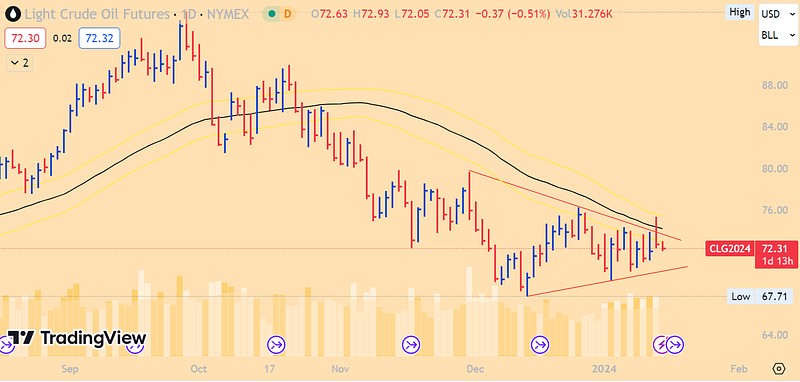Oil markets experienced subtle fluctuations in Asian trade on Monday, driven by a mix of Middle East tensions and anticipation of crucial economic indicators from the US and China.
Saqib Iqbal, an analyst at Trading.Biz, shares insights into the factors influencing oil prices and the key events shaping the energy landscape.
- Oil prices experience fluctuations driven by Middle East tensions and anticipation of crucial US and China economic indicators, with concerns over potential supply disruptions.
- Oil prices take a weak start in 2024 amid uncertainties related to high-interest rates, economic slowdown, and stagnant inflation.
- Russia strategically resumes oil exports to Brazil, increasing the global oil supply.
Late last week, crude oil prices surged following US and UK strikes against the Iran-backed Houthi group, escalating concerns about a broader conflict in the Middle East.
This, coupled with the Israeli-Hamas war, raised fears of potential disruptions to oil supplies from the region. The market is closely monitoring retaliatory actions from the Houthis, who vowed to continue attacks on ships heading to Israel.
Despite the conflict leading to the suspension of certain Red Sea routes, global oil supplies have not been significantly impacted. Authorities at the Suez Canal reassured that traffic along the crucial route remained stable.
However, oil prices are anticipated to face a weak start in 2024 after a more than 10% decline in the previous year. Market uncertainties persist due to factors such as high-interest rates, slowing economic growth, and stagnant inflation.
As of the latest data, Brent crude futures expiring in March fell 0.1% to $78.23 a barrel, while West Texas Intermediate crude futures dropped 0.1% to $72.73 a barrel. Owing to the US national holiday, trading volumes are expected to remain low.
This week, the focus shifts to key economic data releases from the US and China, providing valuable insights into potential demand dynamics. The central bank is expected to cut medium-term lending rates in China to support a slowing economic recovery. Due Wednesday, fourth-quarter GDP data is projected to slightly exceed the government’s target of 5% per annum, driven by a lower year-on-year comparison base.
Saqib Iqbal emphasizes the importance of monitoring China’s fuel demand, which has shown signs of improvement, as evidenced by record-high oil imports in 2023. However, uncertainties loom amid high inventories and ongoing weaknesses in the country’s major economic engines.
In the US, investors should closely watch speeches from Federal Reserve officials for insights into the central bank’s interest rate plans. Retail sales data will also clarify inflation trends following last week’s unexpected rise in the December Consumer Price Index (CPI). Stagnant inflation could delay the Federal Reserve’s interest rate cuts, influencing the strength of the dollar and, subsequently, oil prices.
Shifting focus to global oil dynamics, Saqib Iqbal sheds light on Russia’s strategic move to resume oil exports to Brazil. In September, Russia exported the largest oil shipment to Brazil since 2010, aiming to diversify its list of oil buyers beyond India and China. This move aligns with Russia’s efforts to secure alternative markets.
Brazil, a major oil producer and exporter, benefits from purchasing Russian petroleum products at a discount, addressing domestic refining needs. This shift in oil dynamics marks the first supply from Russia to Brazil since at least 2016. The move has resulted in an increased supply of oil in the world, which creates a selling pressure on crude oil prices.

Technically, the daily chart shows a bearish pennant pattern that indicates a bearish continuation below the $70.00 mark. The Friday’s top could not sustain beyond the 50-day SMA and retraced back to the daily lows.
The bearish pin-bar, 50-day SMA, and the price action pattern create a strong confluence for the sellers. Alternatively, moving beyond the $75.00 area may change the outlook to bullish.



